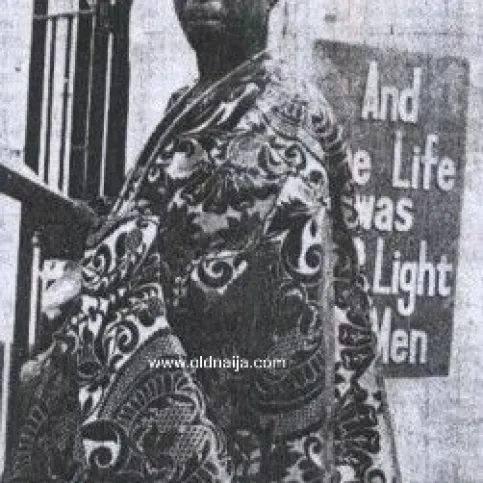Jesu Oyingbo: Who Was He?
Olufunmilayo Immanuel Odumosu, also known as Jesu Oyingbo, a middle-aged Ijebu man, made the shocking declaration that he was the long-awaited Jesus Christ in the 1950s in Lagos, Nigeria. Those who believed him thanked their stars for witnessing Jesus Christ’s second coming with a lot of laughter that was deafening. The second group packed their belongings and moved away from their families and homes to the Jesu Oyingbo communal enclave.
In June 1959, Odumosu made the declaration that he was Jesus Christ and had come to lead people from darkness to light. “I am He,” he stated. I am Jesus Christ, the very one whose second coming the New Testament predicted. I have arrived, and those who have faith in me will experience eternal happiness and life. I am the third person who is missing. I am here to prepare the obedient for the day of judgment.
Odumosu’s shocking declaration and, more importantly, the reasons why some Nigerians believed him may raise questions. Could it have been his apprenticeship with Pa Odubela, his carpenter uncle, which is more like Jesus Christ’s and Joseph’s in the Bible? One thing is certain: Nigerians stormed Jesu Oyingbo’s church in search of an immediate miracle.
The name “Oyingbo” came from Jesu Oyingbo’s church, Universal College of Regeneration, which was initially located in the Oyingbo neighborhood of Lagos. He later moved the church to Immanuel Street, Maryland, Ikeja, Lagos, and Awoyokun Street, Ikorodu Road, Palmgrove.

We learned from the obituary of Jesu Oyingbo that his method of worship was in no way comparable to that of the biblical Jesus Christ and his disciples. In fact, to create his own form of worship, he combined elements of Islam, Christianity, and paganism. Regardless, he remained steadfast in his identity as the adored Jesus Christ and cared less about what other people thought.
The over 700 people who lived in Jesu Oyingbo’s communal enclave included a bakery, a barbershop, a printing press, a construction company, and other businesses. It was, in fact, its own distinct world. Strange sculptures on some of Jesu Oyingbo’s buildings and those in the communal enclave bolstered suspicions that he was involved in a cult.
Jesu Oyingbo’s Church On some of the buildings he owned in Maryland on Immanuel Street, there were inscriptions like “The Lion of Judah,” “Immanuel the Christ,” “Prince of Peace,” “Merciful Father,” and so on. and were surrounded by Jesus Christ, lion, and mermaid statues.
He baptized his new members, instead of using water, with nine strokes of a cane, as if this weren’t enough to disprove his claim to be Jesus Christ. The new converts were free to live in his estate after baptism. Additionally, it was alleged that Jesu Oyingbo’s church was the scene of constant sexual activity and abuse.
It is important to note that as a member of the Universal College of Regeneration, Jesu Oyingbo has the right to take one’s partner and possessions at any time. On one account, he had tied the knot with another member’s wife. Another story says that he married a member’s wife to get back at the man for hurting his wife. Additionally, the enclave was said to have seen a lot of incest.
Due to his undeniable authority over the wives of his members, it was said that Jesu Oyingbo had more than 30 wives and 80 children. However, not all of his children shared his faith or belief in him. Bukola Immanuel, one of his daughters, stated, “I don’t accept him as my savior.” My biological father is him. My only savior is the real Jesus Christ.
Church in Oyingbo Despite this, Olufunmilayo Immanuel Odumosu, also known as the Jesus of Oyingbo, was regarded as a kind and amusing man by his children and neighbors. They said he always smiled and even made jokes while walking around the neighborhood. These assertions are demonstrated by the film screening session that he organized each evening in the neighborhood and enclave. Using a projector that Jesu Oyingbo gave them, people would always gather in the evening to watch movies. Always festive, it was.
According to Jesu Oyingbo’s story, he became extremely wealthy while running his ministry. However, he refuted the claim that he extorted his followers for the majority of his wealth. He claimed to be a businessman and savior who relies on his businesses to run his ministry and polygamous family.
Between the beginning of the 1970s and the end of the 1980s, Jesu Oyingbo shook Lagos and other cities in southwestern Nigeria. Even though his name was used in a Yoruba gospel song that goes like this: He gained widespread popularity. I don’t know Jesus of Oyingbo, I don’t know Jesus of Agege, I don’t know Jesus of Guru Maharaji, but the Jesus I do know is the rock of ages. Emi o mo Jesu Oyingbo, emi o mo Jesu Agege, emi o mo Jesu ti mo mo l’apata ayeraye
Like every other man, the self-described Jesus of Oyingbo passed away in a hospital in 1988 at the age of 73. His church as a whole was thrown into chaos. How could Jesus Christ die when he returned? They questioned. They hoped that he would reappear on the third day.
Unfortunately, Jesu Oyingbo has not yet returned to life, Immanuel Odumosu His ministry was shaken when Jesu Oyingbo passed away because the center could no longer hold. His older children attempted to patch the holes, but instead they got wider. Because Jesu Oyingbo died without a will, his children, wives, and followers got into a big fight.
Olukayode Immanuel Odumosu, his eldest son, took the matter to court, where the atrocities committed in the communal enclave were exposed. However, the court sided with the children in 1997, evicting the enclave’s followers of their father.
Thugs, weed smokers, and criminals frequent the decaying and abandoned buildings that now make up the enclave.

